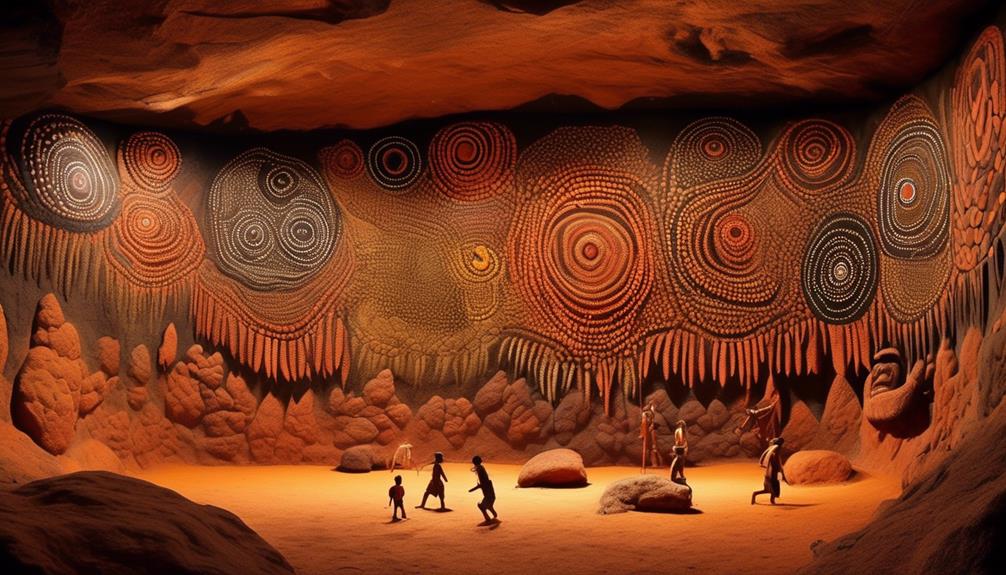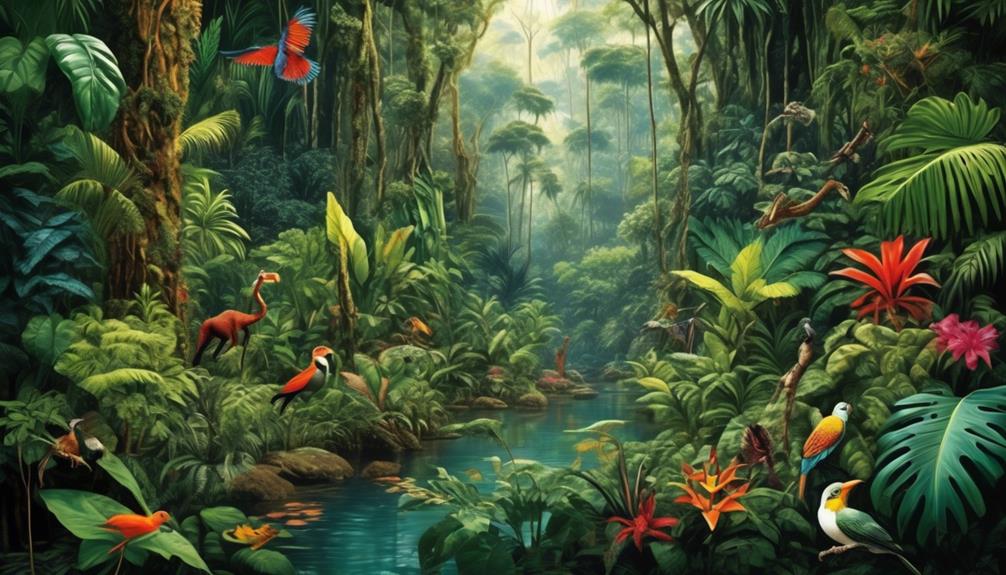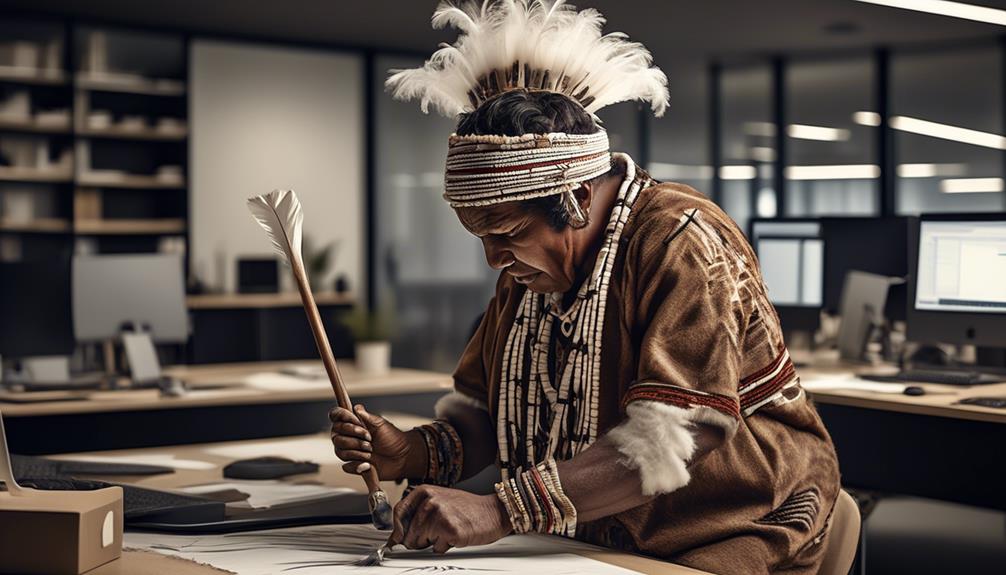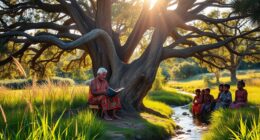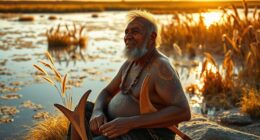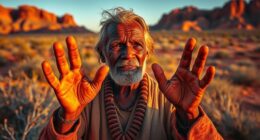When we observe the intricate dot paintings and vibrant rock art made by Aboriginal Australians, we are transported into a world rich with cultural significance and ancient customs.
But what becomes of these masterpieces once they are created? How do they continue to shape the lives and experiences of the Aboriginal communities?
The answers to these questions reveal a complex and fascinating interplay between art, heritage, spirituality, and modern society.
Let's explore the multifaceted roles that Aboriginal art plays in the lives of its creators and admirers.
Key Takeaways
- Aboriginal art preserves and passes on ancestral traditions, stories, ceremonies, and spiritual beliefs.
- Art ensures that ancestral knowledge remains alive and relevant in contemporary society.
- Aboriginal art conveys spiritual narratives and ancestral teachings.
- Indigenous art vividly captures the deep-rooted connection between people and ancestral land.
Cultural Storytelling Through Art
Aboriginal Australian art serves as a powerful medium for cultural storytelling, intricately weaving together narratives of tradition, spirituality, and connection to the land. Cultural expression is deeply embedded within the artistic traditions of Aboriginal Australians, with each artwork carrying layers of meaning that reflect the rich tapestry of their heritage.
Through intricate dot paintings, bark art, rock engravings, and ceremonial body designs, Aboriginal artists communicate their ancestral stories, knowledge, and spiritual beliefs, preserving and passing on traditions from one generation to the next.
The artistic traditions of Aboriginal Australians aren't merely decorative; they're a means of transmitting and safeguarding cultural knowledge. These artworks are imbued with symbolism and meaning, often representing Dreamtime stories that speak of creation, ancestral beings, and the natural world.
The act of creating art itself is a form of cultural expression, reinforcing the interconnectedness of Aboriginal people with their land, spirituality, and identity. In essence, Aboriginal Australian art serves as a living testament to the enduring legacy of cultural storytelling through artistic traditions.
Preservation of Ancestral Knowledge

Transitioning from cultural storytelling through art, we can now examine the vital role of Aboriginal Australian art in preserving ancestral knowledge, serving as a living testament to the enduring legacy of cultural storytelling through artistic traditions.
The preservation of ancestral traditions is deeply embedded in Aboriginal Australian art, reflecting the rich tapestry of stories, ceremonies, and spiritual beliefs passed down through generations. Artistic preservation goes beyond the physical creation of artworks; it encompasses the transmission of knowledge, cultural practices, and spiritual connections to the land.
Each stroke of paint or carving in traditional art forms encapsulates the wisdom and cultural essence of the Aboriginal people, ensuring that their ancestral knowledge remains alive and relevant in contemporary society. Through art, Aboriginal Australians continue to honor and uphold the traditions of their ancestors, instilling a sense of identity, belonging, and pride in their heritage.
It serves as a bridge between the past and the present, allowing the wisdom of the ancestors to guide and inspire future generations, fostering a deep appreciation for the enduring legacy of Aboriginal Australian culture.
Spiritual Significance and Rituals
Exploring the spiritual significance and rituals embedded within Aboriginal Australian art reveals the profound connection between cultural practices and artistic expressions, serving as a testament to the enduring legacy of ancestral beliefs and traditions. Aboriginal Australian art isn't merely decorative; it's intrinsically linked to spiritual practices and ceremonial art use, carrying deep symbolism and meaning.
- Narratives in Art: Aboriginal Australian art serves as a visual medium through which spiritual narratives and ancestral teachings are conveyed, preserving and passing down cultural knowledge through generations.
- *Connection to the Land*: The art often depicts sacred sites, ancestral beings, and the interconnectedness between the people and the land, reflecting the spiritual connection to the environment and the significance of ancestral stories in sustaining cultural identity.
- *Ceremonial Role*: Many artworks are created specifically for use in rituals and ceremonies, where they play a crucial role in facilitating spiritual communication and connection with ancestral beings.
- *Symbolism and Rituals*: The intricate patterns and symbols in the art hold deep spiritual significance, often representing aspects of the Dreamtime, a sacred era of creation and spiritual beliefs.
Understanding the spiritual practices and ceremonial art use embedded within Aboriginal Australian art is essential in appreciating the depth of cultural significance and the enduring relevance of these traditions.
Connection to the Land Through Art
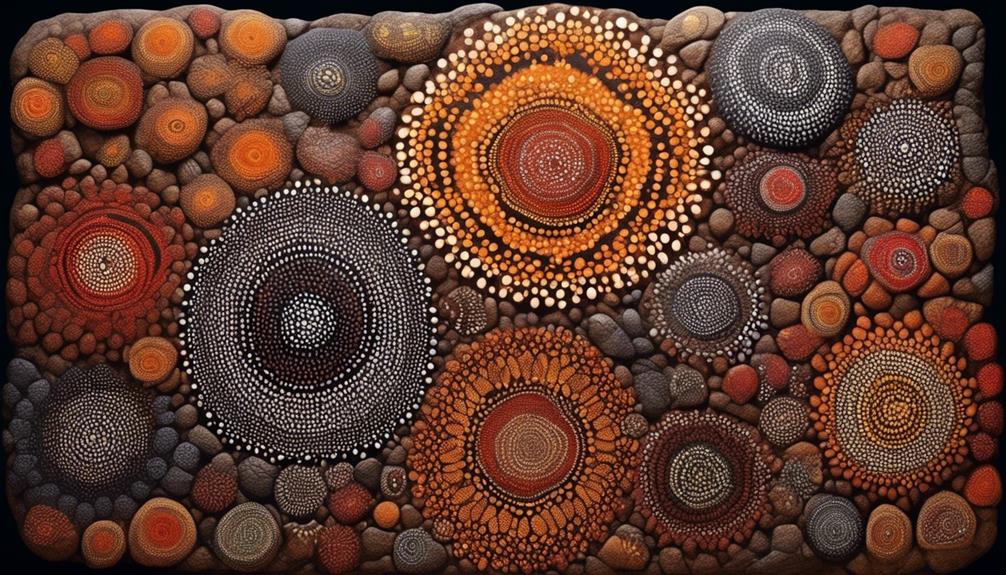
Indigenous Australian art vividly captures the deep-rooted connection between the people and their ancestral land, reflecting a profound intertwining of cultural identity and spiritual significance. The artistic expression of Aboriginal Australians serves as a powerful medium through which their connection to the land is conveyed. This connection goes beyond a mere physical or geographical attachment; it embodies a spiritual and emotional bond that is intricately woven into every stroke and motif.
| Connection | Artistic Expression | Cultural Identity |
|---|---|---|
| Deep | Symbolic imagery | Ancestral stories |
| Sacred | Dreamtime stories | Kinship ties |
| Spiritual | Landscape depictions | Totemic symbols |
| Intertwined | Ritualistic designs | Sacred rituals |
The connection to the land is depicted through symbolic imagery, dreamtime stories, and landscape depictions, each conveying the spiritual and cultural significance of the land. Artistic expression, in the form of ritualistic designs and totemic symbols, further exemplifies the profound connection and reverence Aboriginal Australians hold for their ancestral lands. These artistic representations not only reflect the deep-rooted connection but also serve as a means of preserving and passing on ancestral stories, kinship ties, and sacred rituals, thus enriching the cultural identity of the Aboriginal people.
Economic and Social Significance of Aboriginal Art Industry
The economic and social significance of the Aboriginal art industry is multifaceted, playing a pivotal role in both sustaining cultural heritage and contributing to the livelihoods of Indigenous communities.
- Economic Impact:
- The Aboriginal art industry generates substantial revenue through the sale of traditional artworks, providing economic opportunities for Indigenous artists and their communities.
- It serves as a significant contributor to Australia's cultural tourism, attracting visitors from around the world and bolstering the country's economy.
- The industry also fosters entrepreneurship and innovation, empowering Indigenous individuals to develop sustainable businesses and create employment opportunities within their communities.
- Social Implications:
- Aboriginal art plays a vital role in preserving and transmitting cultural knowledge, strengthening the sense of identity and belonging among Indigenous peoples.
- Through art, Indigenous communities are able to assert their cultural autonomy and challenge historical narratives, contributing to a broader societal understanding of Indigenous perspectives.
- The industry fosters cross-cultural exchange and understanding, promoting dialogue and respect between Indigenous and non-Indigenous Australians.
The economic and social significance of the Aboriginal art industry underscores its pivotal role in not only preserving cultural heritage but also in fostering economic empowerment and social cohesion within Indigenous communities.
Frequently Asked Questions
How Has the Art of Aboriginal Australians Evolved Over Time?
Over time, the art of Aboriginal Australians has evolved through a rich tapestry of techniques and cultural influences.
The evolution of techniques reflects the deep connection to the land and the spiritual significance of storytelling.
Cultural influences, such as the impact of colonization and modernization, have also shaped the art.
These elements have contributed to a dynamic and evolving artistic tradition that continues to captivate and inspire.
What Materials and Techniques Are Commonly Used in Creating Aboriginal Art?
Indigenous techniques and modern materials are used in creating Aboriginal art. Symbolism and storytelling are integral to the art, with each piece carrying deep cultural significance. For instance, did you know that some Aboriginal art can be dated back over 30,000 years? This highlights the enduring traditions and skills passed down through generations.
The fusion of traditional and contemporary elements in Aboriginal art reflects the resilience and adaptability of the culture.
Are There Specific Rules or Traditions That Artists Must Follow When Creating Aboriginal Art?
When creating Aboriginal art, artists have a balance of artistic freedom and adherence to cultural traditions. While there are no strict rules, artists must respect cultural appropriation and ensure their work aligns with traditional stories and symbols. This balance allows for creative expression while honoring the significance and history of the art.
It's essential to approach Aboriginal art with deep respect for the cultural context and traditions that have been passed down through generations.
What Role Do Art Galleries and Museums Play in the Preservation and Promotion of Aboriginal Art?
Art galleries and museums play a crucial role in the preservation, promotion, and cultural exchange of Aboriginal art. They provide a platform for artistic evolution and facilitate a deeper understanding of this rich cultural heritage.
How Do Aboriginal Artists Balance Traditional Cultural Elements With Contemporary Influences in Their Artwork?
In balancing influences, Aboriginal artists skillfully integrate traditional cultural elements with contemporary influences, preserving their heritage while expressing their unique perspectives.
This delicate balance allows for the continuation of cultural traditions while embracing innovation. By doing so, artists honor their ancestors and contribute to the preservation of their cultural legacy, fostering a deeper understanding and appreciation of their heritage for future generations.
Conclusion
In conclusion, the Aboriginal Australians have used their art as a means of cultural storytelling, preserving ancestral knowledge, and connecting to the land spiritually.
This art has also become economically significant, with the Aboriginal art industry generating an estimated $200-300 million annually.
It's important to recognize and respect the deep significance of Aboriginal art in their culture and society.
Mary is a passionate writer who brings creativity and a fresh perspective to our team. Her words have the power to captivate and inspire, making her an essential contributor to our content. Mary’s commitment to storytelling and dedication to promoting Indigenous culture ensures that her work touches the hearts of our readers. We’re fortunate to have her as part of our team.
